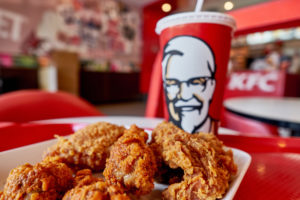
How AI Is Revolutionizing Fast Food

(KULLAPONG PARCHERAT/Shutterstock)
Don’t look now, but big data and machine learning are coming to a fast food outlet near you, as chains both big and small look to augment human-based operations with the latest technology.
If you find yourself in the drive-thru of Denver’s Good Times Burgers and Frozen Custard, your breakfast order likely will be taken by a chatbot, or what The Telegraph has termed a “burger bot.”
In January, the burger joint started using AI technology developed by Vaylant AI to take orders from customers. The idea is to augment the human workforce to ensure that orders from the drive-thru window are taken promptly.
“Good Times Restaurants are usually staffed with three employees at breakfast,” states Good Times COO Scott Lefever. “If there is inclement weather, or if an employee doesn’t show up, Valyant’s platform can truly save the morning.”
Vaylant AI’s burger bot appears to be working. According to the Denver-based firm, the average wait time for customers has improved by 10% to 25%, and the average order at Good Times is up 6%. The platform’s average attempted upsell success rate is 40%, Vaylant AI claims.
AI is also coming to national chains, like McDonald’s, which this spring began testing image recognition and menu customization technologies in its drive-thrus. Drive-thrus account for 70% of revenue at fast food restaurants, according to industry metrics.
In March, McDonald’s acquired Dynamic Yield Ltd., an Israeli company that specializes in personalization and decision logic. The Chicago-based chain, which has more than 38,000 locations around the world and has famously served over 99 billion burgers, reportedly paid $300 million for the firm.
Dynamic Yield’s technology will enable restaurants to customize the contents of drive-thru menu based on variables like time of day, weather, current restaurant traffic, and trending menu items. Menus will also change in response to customer’s orders.
McDonald’s was expected to roll-out the AI technology at 1,000 restaurants by now, with plans to fully implement it at all 14,000 US locations eventually. “With this acquisition, we’re expanding both our ability to increase the role technology and data will play in our future and the speed with which we’ll be able to implement our vision of creating more personalized experiences for our customers,” said McDonald’s CEO and President Steve Easterbrook.
This isn’t McDonald’s first foray into big data. The company already offers a mobile app that allows customer to order food. Thanks to geofencing technology, restaurants are alerted to prepare the food when the customer nears the restaurant. As customers share more information about themselves through mobile apps and other forms of data collection, such as license-plate readers in the drive-thru, it will empower even greater levels of personalization, Easterbrook said.
From self-order kiosks and back-office automation, McDonald’s has no shortage of planned uses for big data, Easterbrook told Wired earlier this year. “If customers are willing to identify themselves…we can be even more useful to them, because now we call up their favorites,” the CEO told Wired.
Domino’s Pizza has also embarked on several AI projects, including the use of voice recognition software for ordering pizzas, as well as image recognition systems for ensuring the quality of pies.
In 2017, Domino’s worked with natural language processing (NLP) leader Nuance to developed DRU Assist, which allows customers to order a pizza using voice commands. Since then, the company has launched Domino’s Anyware, which extends the voice ordering feature to Google Home, Amazon Alexa, Facebook Messenger, Twitter, Slack, Ford Sync, Samsung Smart TV, and via text.
More recently, the $2.5-billion pizza giant has implemented AI for pizza-making operations. Earlier this year, the company’s Australian and New Zealand arm implemented the DOM Pizza Checker, which uses a ceiling-mounted camera to photograph every outgoing pizza to ensure that it’s the right pizza and that the proper amount of ingredients are included on the pie.
The technology uses “advanced machine learning” technology developed by Dragontail Systems, the company says. “DOM Pizza Checker gives our customers the confidence that their pizza will look as it should,” says Nick Knight, the CEO of Domino’s Pizza in Australia and New Zealand.
It’s unclear if the Ann Arbor, Michigan food company plans to implement the DOM Pizza Checker worldwide. But one thing’s for certain: Domino’s not afraid to take a risk with technology. And with 90x stock growth since 2010, which has outperformed many tech firms, the company is clearly doing something right.
Not to be outdone, Yum Brands, which owns KFC, Pizza Hut, and Taco Bell, is also ramping up its use of big data tech, particularly in the lucrative Chinese market, where the company is opening two new stores per day.
According to an article in Bloomberg Businessweek, 86% of Chinese transactions at these stores are cashless, and about half of orders are placed via mobile apps or digital kiosks. With more than 180 million members the KFC and Pizza Hut loyalty programs, there’s a lucrative opportunity to leverage AI tech to customize menu items according to each individual’s taste.
The AI is working. Yum says AI advances have boosted spending on each order by an average of 1%, which translates into hundreds of millions of dollars in extra revenue.
Related Items:
How Brick and Mortar Retailers Can Avoid Getting Amazoned With Big Data
Unlocking Retail’s Big Data Opportunity































